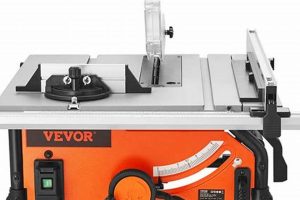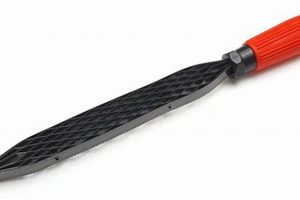This specialized hand tool is characterized by a delicate, fine-toothed blade stretched taut within a C-shaped frame. It is primarily employed for creating intricate curves and detailed cuts in thin materials, such as wood, metal, or plastic. Examples of its application include creating decorative inlays, complex patterns for scrollwork, and precise cutouts in jewelry making.
Its value lies in its capacity to execute cuts that are impossible to achieve with larger, more cumbersome saws. Historically, it has been integral to the creation of ornate furniture, musical instruments, and other finely crafted objects. The precision it offers enhances the aesthetic appeal and functional complexity of the finished product.
The following discussion will delve into the various types of this tool, the proper techniques for its utilization, and the maintenance procedures necessary to ensure its longevity and optimal performance. Considerations for blade selection and frame tensioning will also be addressed.
Tips for Optimal Use
Effective utilization requires adherence to specific guidelines to ensure accuracy, efficiency, and tool longevity.
Tip 1: Blade Selection: The choice of blade should correspond directly to the material being cut. Finer teeth are suitable for hardwoods and intricate designs, while coarser teeth are appropriate for softer woods and faster cutting. Consider the teeth-per-inch (TPI) rating for optimal performance.
Tip 2: Frame Tension: Consistent and adequate tension on the blade is crucial for clean cuts. Insufficient tension leads to wandering cuts and blade breakage, while excessive tension can deform the frame or snap the blade. Adjust tension according to the manufacturer’s recommendations.
Tip 3: Proper Posture and Grip: Maintain a stable posture and a firm grip on the handle. Guide the tool smoothly and deliberately, avoiding jerky movements. Ensure adequate lighting and a comfortable working height to minimize fatigue and maximize control.
Tip 4: Cutting Technique: Use a steady, up-and-down motion, applying slight pressure on the downstroke. Rotate the material rather than forcing the blade to turn tight corners. Employ wax or lubricant to reduce friction and heat buildup, especially when cutting denser materials.
Tip 5: Blade Changes: Replace worn or broken blades immediately. Inspect the blade regularly for signs of wear or damage. Use a blade-changing tool to avoid injury. Ensure the blade is properly aligned and securely fastened within the frame.
Tip 6: Material Support: Secure the workpiece firmly to a stable surface, such as a bench hook or fret saw table. This prevents vibration and ensures clean, accurate cuts. Use clamps or vises as necessary.
Tip 7: Regular Maintenance: Clean the tool after each use, removing sawdust and debris. Apply a light coat of oil to prevent rust and corrosion. Store the tool in a dry, secure location to protect it from damage.
Mastering these techniques will enhance the precision and quality of work, reduce the risk of injury, and extend the lifespan of the tool.
The subsequent section will cover troubleshooting common problems encountered during its operation.
1. Blade Tension Adjustment
Blade tension adjustment is a critical aspect of woodworking fret saw operation. It directly influences cutting precision, blade longevity, and the overall quality of the finished workpiece. Proper adjustment ensures the blade remains taut and stable, preventing undesirable flexing or wandering during the cutting process.
- Precision Cutting
Appropriate blade tension is paramount for achieving accurate cuts. Insufficient tension allows the blade to deflect, leading to inaccurate lines and compromised details in intricate designs. Over-tensioning, conversely, risks blade breakage and potential damage to the tool frame. Fine adjustments ensure the blade tracks accurately, enabling the creation of clean, precise cuts, particularly when executing tight curves and complex shapes.
- Blade Longevity
Maintaining correct blade tension significantly extends blade lifespan. A blade that is too loose experiences increased stress from vibration and bending, accelerating wear and fatigue. Excessively tight blades are prone to snapping under pressure. Properly tensioned blades distribute stress evenly, minimizing wear and breakage and ultimately reducing the frequency of blade replacements.
- Cutting Efficiency
Optimal tension translates directly to cutting efficiency. A well-tensioned blade bites into the material more effectively, allowing for smoother, faster cutting with less effort. Improper tension requires increased force, leading to operator fatigue and a higher risk of mistakes. Consistent, efficient cutting reduces the time required to complete projects and improves overall productivity.
- Material Compatibility
The ideal blade tension may vary depending on the material being cut. Softer woods may require slightly less tension than hardwoods to prevent blade binding or breakage. Adjusting tension according to the material properties ensures optimal performance and minimizes the risk of damage to both the blade and the workpiece. A flexible adjustment mechanism allows for adapting to a wider range of materials and project requirements.
These facets highlight the indispensable role of blade tension adjustment in woodworking. It is not merely a mechanical step, but a foundational element for achieving precise, efficient, and sustainable results when using this tool. Mastery of tensioning techniques directly translates to enhanced craftsmanship and a reduction in material waste. Proper understanding also ensures longevity of your woodworking fret saw’s frame and its parts.
2. Cutting Angle Precision
Cutting angle precision is a fundamental element in woodworking using a fret saw, significantly influencing the accuracy and aesthetic quality of the final product. Achieving precise angles requires a combination of technique, tool mastery, and an understanding of the material properties being worked upon.
- Intricate Design Execution
Precise cutting angles enable the creation of complex and detailed designs. Whether replicating historical patterns, crafting custom inlays, or producing geometrically complex art pieces, the ability to accurately control the blade angle is paramount. Errors in angle result in visible flaws and deviations from the intended design.
- Joint Integrity in Assemblies
In applications where the fret saw is used to create components for larger assemblies, precise cutting angles ensure tight, seamless joints. Angled cuts must be exact to allow pieces to fit together correctly, maintaining structural integrity and visual appeal. Inaccurate angles lead to gaps, weak joints, and an unprofessional finish.
- Minimizing Material Waste
Precise angle control reduces the amount of material wasted during the cutting process. Accurate cuts minimize the need for corrective sanding or adjustments, preventing the unnecessary removal of material. This is particularly important when working with expensive or rare woods, where minimizing waste is both economically and ecologically advantageous.
- Consistent Replication
The ability to consistently replicate cutting angles is crucial for producing multiple identical components. Whether creating matching chair spindles, reproducing decorative elements, or fabricating parts for a production run, precise angle control ensures uniformity and consistency across all pieces.
In summary, cutting angle precision is an indispensable skill for effective utilization. Its mastery ensures not only accurate and aesthetically pleasing results but also contributes to material efficiency and the ability to replicate designs consistently. The degree to which a woodworker can control cutting angles directly reflects the quality and sophistication of their work.
3. Frame Durability
The frame is a critical structural component directly influencing the tools performance, longevity, and overall usability. The ability of the frame to withstand the stresses of repeated use and maintain its integrity is paramount for accurate cutting and efficient operation.
- Material Composition and Resilience
The frame’s construction material significantly dictates its durability. High-carbon steel frames, for example, offer superior resistance to bending and deformation compared to lower-grade alternatives. This resilience ensures the blade remains under consistent tension, contributing to precise cuts. Conversely, a frame constructed from a weaker material is prone to flex, resulting in inaccurate cuts and potential frame failure under sustained use. Consider a situation where a woodworker is cutting through a dense hardwood; a robust frame will maintain its shape, while a weaker frame may warp, compromising the cut.
- Joint Integrity and Stability
The points where the frame connects to the handle and blade-holding mechanisms are critical stress points. Well-engineered joints, often reinforced with welding or robust mechanical fasteners, enhance the overall durability. Weak or poorly constructed joints are susceptible to loosening or breakage over time, leading to instability and reduced cutting precision. An example would be the continuous stress placed on the upper and lower arms of the ‘C’ frame; if these connections are weak, the entire structure is compromised.
- Resistance to Corrosion and Wear
Exposure to moisture and the abrasive effects of sawdust can degrade the frame over time. A durable frame should possess a protective coating or be constructed from a material resistant to corrosion and wear. Powder-coated steel or stainless steel frames, for example, offer superior protection against rust and degradation compared to uncoated steel. In humid environments, this becomes especially important, preventing premature weakening of the frame.
- Ergonomic Impact and Fatigue Reduction
While directly related to durability, the frame’s design also affects ergonomics. A well-designed frame distributes weight evenly and minimizes vibration, reducing user fatigue during extended periods of use. A poorly designed frame can cause discomfort and strain, negatively impacting the operator’s ability to maintain precision and control, indirectly affecting the quality and longevity of the tool’s use.
The aspects of material, joint integrity, corrosion resistance, and ergonomic design collectively determine its ability to withstand the rigors of woodworking. Investing in a tool with a durable frame translates to improved accuracy, extended lifespan, and a more comfortable and efficient working experience.
4. Material Compatibility
Material compatibility, in the context of woodworking with a fret saw, refers to the suitability of a given material for cutting with the tool, considering factors such as hardness, density, thickness, and the blade’s properties. Proper material selection and matching of blade characteristics are essential for achieving clean cuts, preventing blade breakage, and ensuring the longevity of the tool.
- Wood Hardness and Blade Selection
The hardness of wood significantly influences blade selection. Hardwoods like oak and maple require finer-toothed blades with higher TPI (teeth per inch) to prevent tear-out and ensure smooth cuts. Softwoods, such as pine and cedar, can be cut with coarser blades for faster material removal. Using an inappropriate blade can lead to ragged edges, blade binding, and increased cutting resistance. For instance, employing a coarse blade on a dense hardwood will likely result in splintering and a rough surface finish, whereas a fine blade on a soft wood may clog quickly, reducing cutting efficiency.
- Material Thickness and Frame Capacity
Material thickness is constrained by the depth of the fret saw’s frame. Attempting to cut material thicker than the frame’s capacity is impossible. Additionally, thicker materials generally require slower cutting speeds and increased blade tension to maintain accuracy and prevent deflection. When working with plywood, consideration must be given to the adhesive used in its construction, as some adhesives can dull blades rapidly. It is crucial to assess if the piece to be cut is compatible with the saw’s size capacity.
- Exotic Materials and Specialized Blades
Beyond wood, the fret saw can be employed on materials like thin metals, plastics, and composites. However, these materials necessitate specialized blades designed for their unique properties. Cutting metal requires blades with hardened teeth and often benefits from lubrication to reduce friction and heat buildup. Plastics may require blades with specific tooth geometries to prevent melting or chipping. The selection of a compatible blade is crucial to ensure the successful cutting of material while preserving its integrity, minimizing damage and extending blade’s life.
- Material Density and Cutting Speed
Material density is inversely proportional to cutting speed when using a fret saw. Denser materials require slower, more deliberate strokes to allow the blade to effectively remove material. Attempting to force the blade through a dense material can lead to blade breakage or inaccurate cuts. A woodworker must balance the need for efficiency with the properties of the material to ensure controlled cutting and prevent damage to the blade.
Therefore, material compatibility is a multi-faceted consideration when operating a fret saw. The selection of appropriate blades, consideration of material thickness, understanding the properties of exotic materials, and adjusting cutting speeds based on density are all essential for maximizing the tool’s potential and achieving high-quality results. Disregard for these principles can lead to suboptimal outcomes and premature tool wear.
5. Blade Tooth Geometry
Blade tooth geometry constitutes a fundamental determinant of a woodworking fret saw’s performance. The shape, size, and arrangement of teeth on the blade directly influence cutting speed, precision, and the quality of the resulting finish. Understanding these geometric parameters is crucial for selecting the appropriate blade for a given material and application.
- Tooth Pitch and Material Density
Tooth pitch, defined as the number of teeth per inch (TPI), dictates the blade’s suitability for materials of varying densities. Higher TPI blades, characterized by finer teeth, are generally preferred for hardwoods and thin materials, as they produce smoother cuts with reduced tear-out. Lower TPI blades, possessing coarser teeth, facilitate faster material removal in softer woods but may compromise finish quality. The selection of an appropriate tooth pitch necessitates careful consideration of the material’s density to optimize cutting efficiency and minimize surface defects.
- Tooth Angle and Cutting Aggressiveness
The angle at which the teeth are sharpened, often referred to as the rake angle, influences the aggressiveness of the cut. Steeper rake angles promote more aggressive cutting but may also increase the risk of tear-out and blade chatter. Shallower rake angles provide smoother, more controlled cuts, albeit at a reduced cutting speed. The optimal rake angle depends on the wood species, grain orientation, and the desired level of precision. Adjusting rake angle improves the interaction between material and blade.
- Tooth Set and Kerf Width
Tooth set refers to the alternating offset of teeth to either side of the blade, creating a kerf wider than the blade’s thickness. This wider kerf reduces friction and prevents the blade from binding in the cut. The amount of set influences the ease of cutting and the smoothness of the resulting surface. Excessive set can lead to a rough cut, while insufficient set may cause the blade to overheat and bind. Kerf is related to how much material blade remove.
- Tooth Shape and Material Type
Various tooth shapes are designed for specific materials. Standard teeth are suitable for general-purpose woodworking. Skip teeth, with alternating unset teeth, are effective for cutting plastics and other materials prone to melting or chipping. Hook teeth, featuring a pronounced forward angle, are aggressive cutters ideal for thick materials. Selecting a tooth shape appropriate for the material being cut ensures optimal performance and minimizes the risk of damage to the blade or workpiece. These blade-specific shapes increase the longevity of the blade and workpiece.
These elements of blade tooth geometrytooth pitch, angle, set, and shapecollectively determine the effectiveness of a woodworking fret saw. Careful selection and application of blades based on these parameters are essential for achieving accurate, efficient, and high-quality results across a range of woodworking tasks. A keen understanding of the aforementioned blade aspects allows for maximization of the woodworking fret saw’s performance.
Frequently Asked Questions about Woodworking Fret Saws
The following addresses common inquiries regarding usage, maintenance, and selection to enhance operational understanding.
Question 1: What distinguishes it from a coping saw?
The woodworking fret saw possesses a finer blade and a deeper frame than a coping saw, enabling more intricate cuts and access to greater depths within a workpiece.
Question 2: How frequently should blades be replaced?
Blade replacement frequency depends on usage intensity and material hardness. Blades should be replaced when dullness is evident, or breakage occurs. Regular inspection is advised.
Question 3: What is the appropriate blade tension for optimal performance?
Appropriate blade tension is crucial. It should be taut enough to prevent wandering during cuts but not so tight as to risk blade breakage. Consult the tool manufacturers recommendations for specific tension guidelines.
Question 4: Is lubrication necessary during operation?
Lubrication is advisable, particularly when cutting dense hardwoods or metals. Wax or specialized lubricants reduce friction and heat, extending blade life and improving cutting efficiency.
Question 5: What safety precautions should be observed?
Eye protection is essential to prevent injury from flying debris. Additionally, ensure the workpiece is securely clamped to a stable surface to prevent movement during cutting. Hands should be kept clear of the blade’s path.
Question 6: Can it be used on materials other than wood?
The woodworking fret saw is adaptable to various materials, including thin metals, plastics, and composites. However, specialized blades designed for these materials are necessary for optimal results and to prevent damage to the tool.
These frequently asked questions highlight essential aspects of utilizing it. Adherence to these guidelines facilitates efficient and safe operation.
The subsequent discussion will explore advanced techniques for enhancing precision and control.
Concluding Remarks
This exploration of the woodworking fret saw has illuminated its core functionalities, optimal utilization techniques, and crucial maintenance procedures. From blade selection to frame tensioning and material compatibility, understanding these fundamental aspects is essential for maximizing the tool’s potential and achieving precision in detailed woodworking projects.
Continued refinement of these skills and consistent adherence to safety protocols will not only enhance the quality of craftsmanship but also ensure the longevity of this indispensable tool. Mastery of the woodworking fret saw represents a commitment to excellence in woodworking practices.







